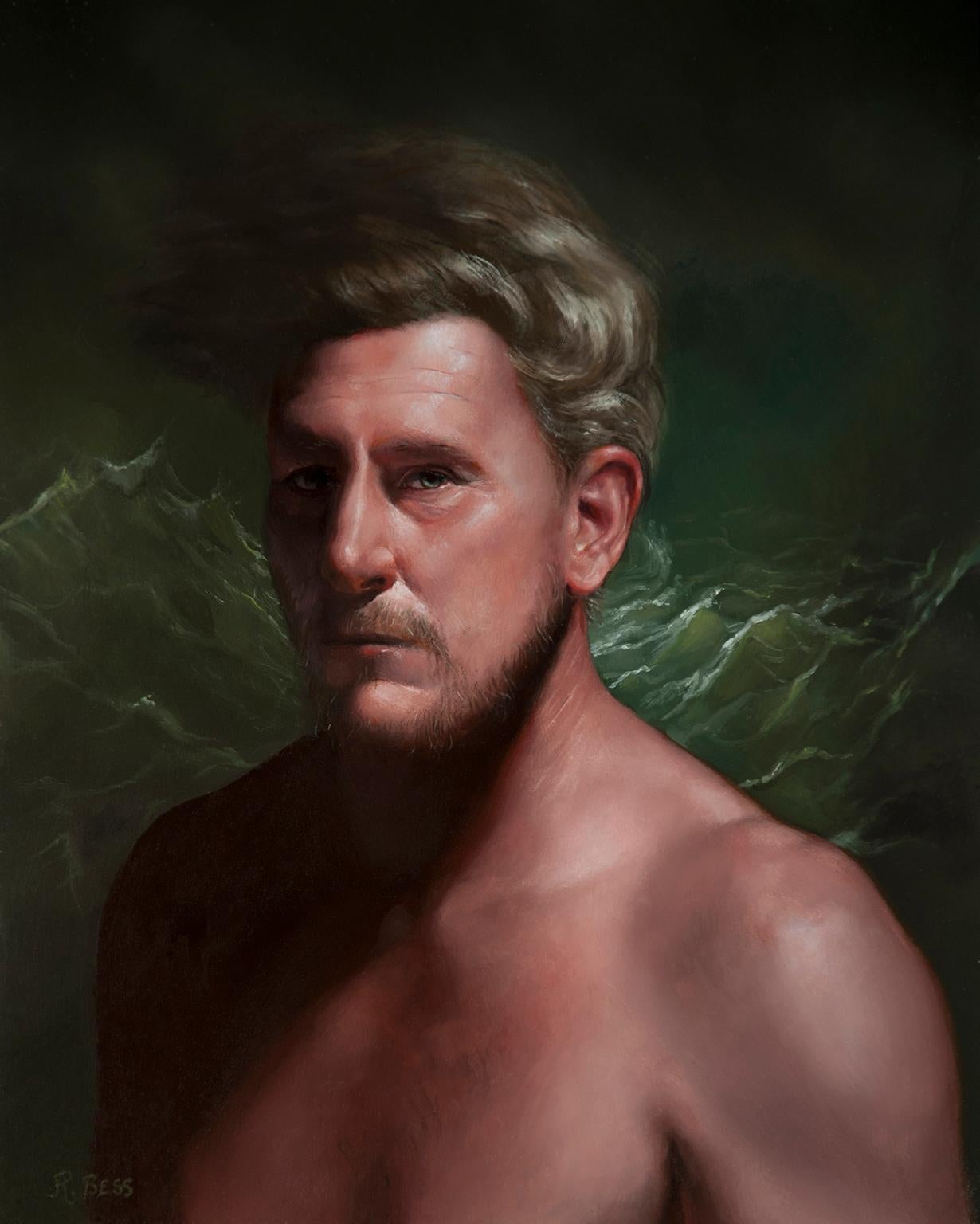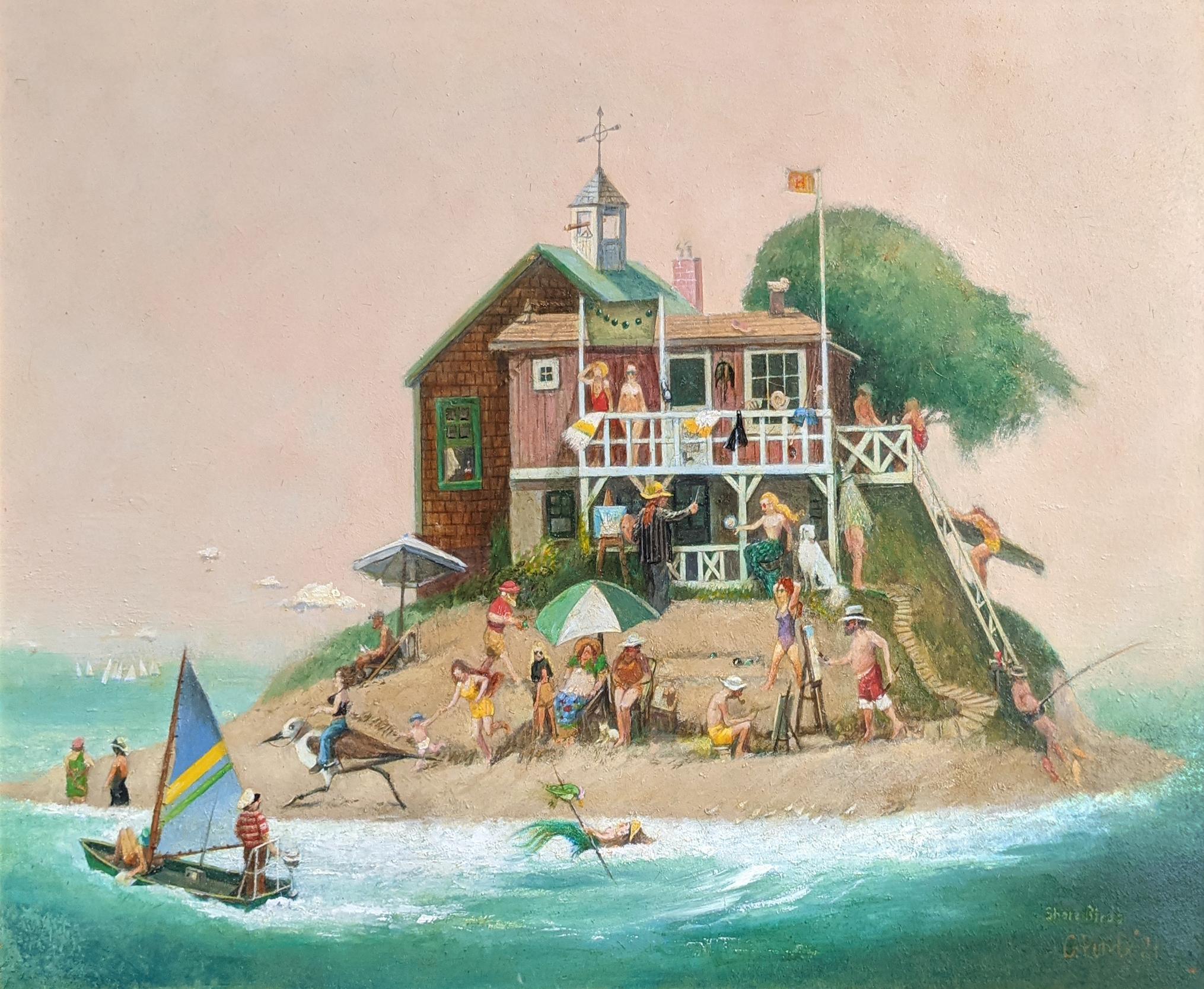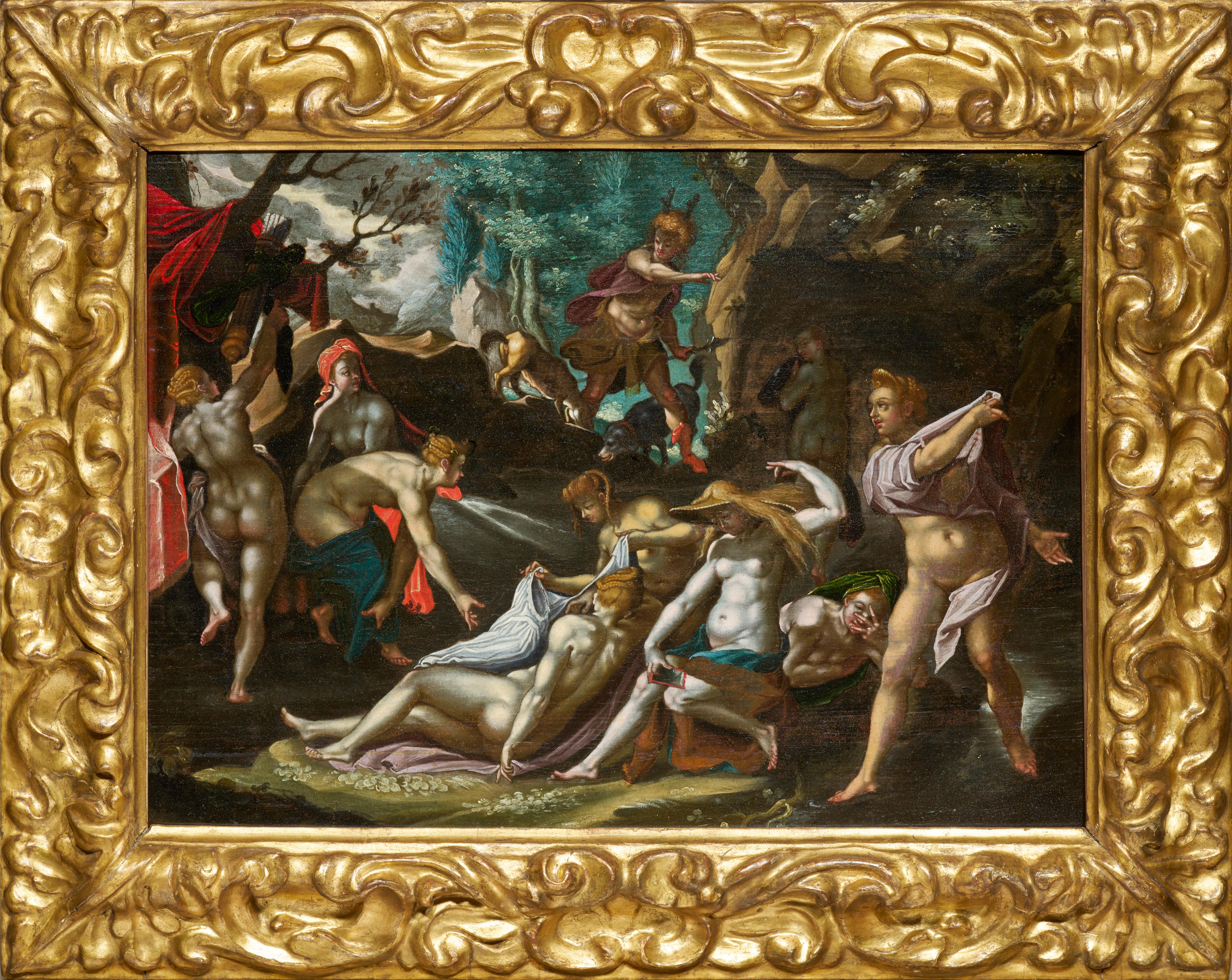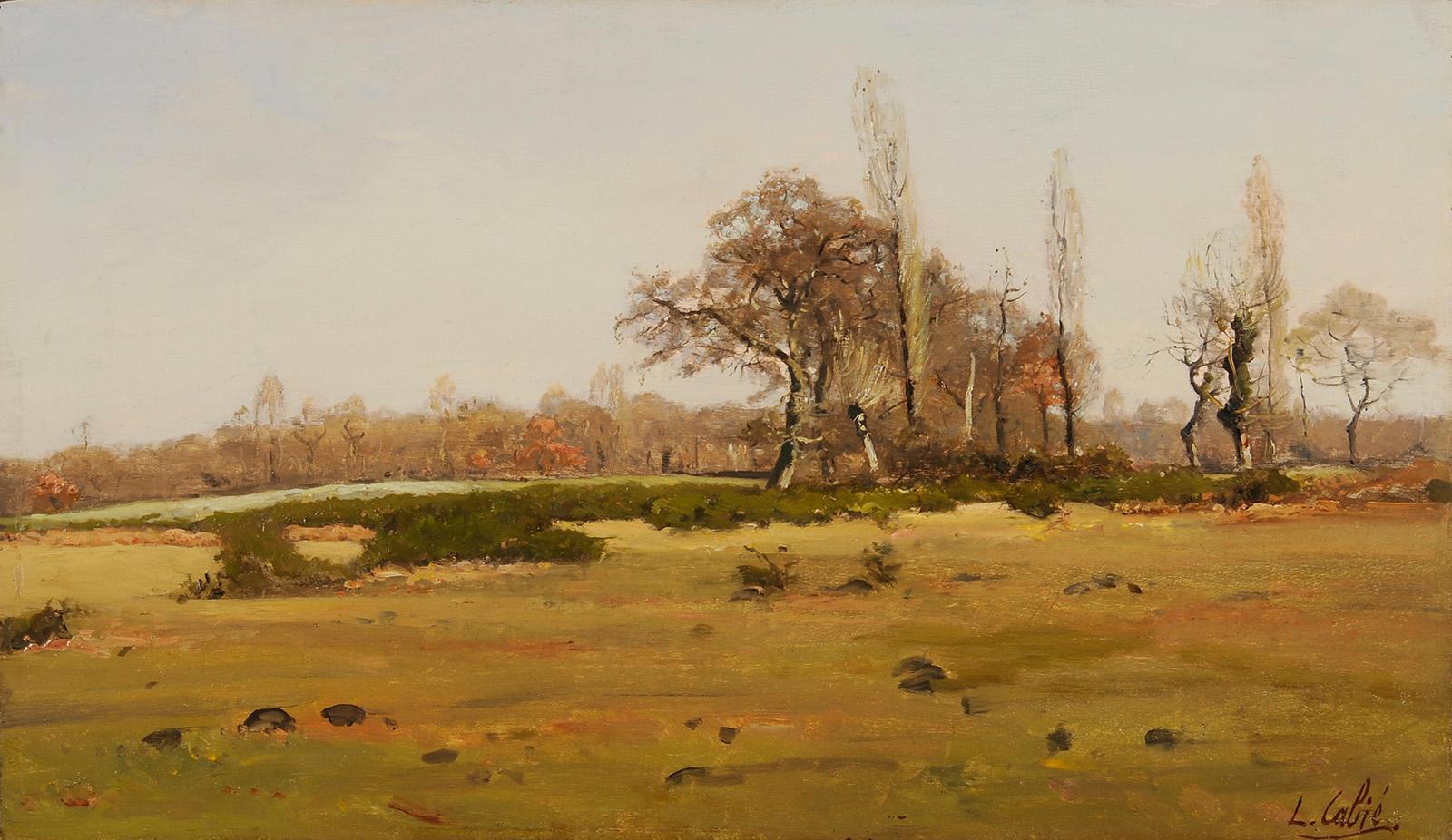Items Similar to Prometheus
Want more images or videos?
Request additional images or videos from the seller
1 of 6
Maxfield ParrishPrometheus1919
1919
About the Item
Medium: Oil on Panel
Sight Size 31.00" x 21.25", Framed 36.00" x 22.00"
Signature: Signed Lower Left
Maxfield Parrish began his career at age 25 as an illustrator, painting magazine covers, advertisements, posters and book illustrations. He was already a well-respected commercial artist when, in 1917, he received a commission from General Electric to produce annual calendar illustrations to advertise the company’s Electric-Edison Mazda Lamps. Eager to sell their product as new and innovative, GE executives asked the artist to emphasize the many facets of light: natural, manmade and fantastical. Over the course of the next 15 years, Parrish created a group of 17 paintings illustrating the progression of the history of light, the immense popularity of which transformed the artist into a national icon. Between 1917 and 1931, over 20 million copies of the calendar were painstakingly reproduced in two different sizes and four different colors. Parrish enjoyed painting images for calendars, because he loved the immediacy and ubiquity of these commissions: far more people would gain exposure to his work in the offices, banks and stores where the calendars commonly hung. If the artist was not already well-known in popular culture through his illustrations and other ads, Parrish became a household name through the Mazda commission.
Prometheus, painted in 1919 and published the following year, visually translates a mythical tale of Prometheus, the Titan who stole fire from the Olympian gods and presented it to early man, thus allowing for the evolution of civilization and cultural progress. As a result of this act, Prometheus became the patron of all earthly artists and thinkers as he brought enlightenment to the world. Parrish emphasizes this heroic interpretation in the present work by depicting the subject in clear mythological glory. Bathed in a warm golden light, Prometheus is rendered in the classical Greek style, idealized and youthful, returning triumphantly to earth bearing the flame of the gods. Although the scene’s iconography is predominantly appropriated ancient Greek sources, Prometheus characteristically incorporates such diverse influences as Old Master principles, Pre-Raphaelite aesthetics, and Parrish’s own vivid imagination to achieve a fantastical scene that both appealed to popular imagination and was perfectly suited to the corporate image GE wanted to project.
The preternatural landscape rendered behind the figure was likely conjured by Parrish’s fertile imagination; he created these make-believe “Parrishscapes” by synthesizing both real and imagined natural elements. Behind the protagonist, a distant view reveals a mysterious mountainous landscape. The artist’s dazzling gifts as a colorist reveal themselves as the dramatic moonlight beams down upon the crystal calm lake and the craggy outcroppings that surround it. The velvety, midnight blue was reportedly inspired by the effects of light filtering through the cloud layer that Parrish felt was specific to New England: “There is an intense blue in New England,” he once wrote. “Put a mountain here, against the east, in a clear sunset glow, and it would be more startling than in Arizona” (quoted in Alma Gilbert, The Masterworks, Berkeley, California, 1992, p. 103). The present work exhibits a remarkable luminosity and purity of colors that Parrish attained by painting with layers of transparent colored glazes, now considered a hallmark of his distinctive style. Displaying lush color effects and an extraordinary attention to detail, Prometheus impressively demonstrates the unique style and vivid imagination that has earned Parrish his place among the most celebrated and beloved of American illustrators.
Exhibited
Chadds Ford, Pennsylvania, Brandywine River Museum, Maxfield Parrish, Master of Make-Believe: An Exhibition, June-September 1974, no. 58
San Mateo, California, La Galeria, Maxfield Parrish, 1976
Windsor, Vermont, The Oaks: Maxfield Parrish Museum, June-August 1978
Currently Being Exhibited At: Brandywine River Museum, A Date with Art: The Business of Illustrated Calendars, January 25, 2014- May 18, 2014
Literature
Coy Ludwig, Maxfield Parrish, New York, 1973, pp. 126, 137, pl. 37, illustrated in color
Paul W. Skeeters, Maxfield Parrish: The Early Years, 1893-1930, Secaucus, New Jersey, 1973, p. 71, illustrated in color
Laurence S. Cutler, Judy Goffman and The American Illustrators Gallery,Maxfield Parrish, London, 1993, p. 69, illustrated in color p. 68
Alma Gilbert, Maxfield Parrish: The Masterworks, Berkeley, California, 1995, fig. 5.4, pp. 96, 97, 113, illustrated in color p. 101
Laurence S. Cutler, Judy Goffman Cutler and the National Museum of American Illustration, Maxfield Parrish and the American Imagists, Edison, New Jersey, 2004, p. 269, illustrated in color
- Creator:Maxfield Parrish (1870-1966, American)
- Creation Year:1919
- Dimensions:Height: 31 in (78.74 cm)Width: 21.25 in (53.98 cm)
- Medium:
- Period:
- Condition:
- Gallery Location:Fort Washington, PA
- Reference Number:1stDibs: LU38431688453
About the Seller
5.0
Recognized Seller
These prestigious sellers are industry leaders and represent the highest echelon for item quality and design.
Established in 1995
1stDibs seller since 2016
107 sales on 1stDibs
Typical response time: 5 hours
- ShippingRetrieving quote...Ships From: Fort Washington, PA
- Return PolicyA return for this item may be initiated within 14 days of delivery.
More From This SellerView All
- Couple in a Horse-Drawn CarriageBy William Henry Dethlef KoernerLocated in Fort Washington, PADate: 1923 Medium: Oil on Panel Dimensions: 24.00" x 36.00"Category
1920s Figurative Paintings
MaterialsOil, Panel
- Four Women in a Fanciful Garden SettingBy Howard Chandler ChristyLocated in Fort Washington, PAMedium: Oil on Panel in Three Parts Dimensions: 66.25" x 71.75" Signature: Signed and Dated 'Howard Chandler Christy/1929' (the third panel, lower right)Category
Early 20th Century Figurative Paintings
MaterialsOil, Panel
- French Military on HorsebackBy Jules DelaunayLocated in Fort Washington, PADate: 1893 Medium: Oil on Panel Dimensions: 14.50" x 21.00" Signature: Signed and Dated Lower Right: J. Delaunay. 1893Category
1890s Figurative Paintings
MaterialsOil, Panel
- Laurel & HardyLocated in Fort Washington, PAMedium: Oil on Wood Panel Signature: Unsigned This Stan Laurel and Oliver Hardy illustration was used as a traveling show sign.Category
1940s Figurative Paintings
MaterialsWood, Oil, Panel, Wood Panel
- Mask and WigBy Maxfield ParrishLocated in Fort Washington, PAMedium: Oil on Wood Panel Signature: Signed ‘Parrish’ (On the Reverse) Finished painting done as a prototype for the mural at the University of Pennsylvania LITERATURE L.S. Cutler ...Category
1890s Figurative Paintings
MaterialsOil, Wood Panel
- A Dark FuturistBy Maxfield ParrishLocated in Fort Washington, PAMedium: Oil on Paper Laid on Panel Signature: Signed Lower Right Initialed lower right: M.P. Signed on the reverse: Maxfield Parish Initialed and numbered by the artist's son on the reverse: M.P. Jr. / No. 68. When Maxfield Parrish painted the comical A Dark Futurist in 1923 for Life magazine, he had already established himself as America's leading book and magazine illustrator. His early artwork for children's classics like L. Frank Baum's Mother Goose in Prose (1897), Kenneth Grahame's Dream Days (1900), and Eugene Field's Poems of Childhood (1904) popularized his signature atmospheric settings, cobalt blue-and-gold palette, and dreamy figures inhabiting magical worlds. Likewise, his covers for Century, Collier's, Harper's Bazaar, Ladies' Home Journal, Life, and Scribner's Magazine were highly desirous and instantly recognizable, often more stylized than his book imagery; no other journal illustrator could match Parrish's winning combination of precise draftsmanship, strong graphic design, and amusing characters. According to David Apatoff, Art Critic, The Saturday Evening Post, "Parrish abandoned his customary heavy details and rainbow colors to present a bolder, more high-contrast design silhouetted against a stark white background - a treatment more suitable for a modern magazine cover vying for attention on a crowded newsstand. A Dark Futurist is silhouetted against a white field with no background or details to prop it up. The composition is carefully centered with only differences in the hands and the artist's necktie to break the symmetry. These are crucial to the success of the design. Just as important as Parrish's clean, high-contrast style in these pictures is the refreshing humor and sophistication in content, which is usually absent from Parrish's fairytale paintings. A Dark Futurist shows us a different kind of modernism. Parrish steps out of his timeless fairy tales to tweak one of the most incendiary artistic movements of his day. Futurism, with its militant manifesto and its outspoken artists, was all the rage in Europe. Parrish pokes them, showing a "dark" and anxious futurist with pursed lips and thick glasses, poised to paint but not exactly sure of, or optimistic about, what the 'future' will hold. This suggests that Parrish was alert to, and had opinions about, current events of the day - something one might never guess from his usual subject matter." In his early Collier's illustrations, Parrish also developed memorable themes that he would return to in his 1920s magazine work. One of his most popular characters was the "seer," or man with keen visual powers, most often depicted as an artist, but also appearing as a tourist, scientist, and philosopher. Parrish's seer was recognizable by particular physical attributes: round glasses, indicating his visual and analytical acuity, and an overcoat and/or hat signifying his role as observer of the outside world. A Man of Letters, sold last year at Heritage Auctions, was one of the first Life covers Parrish rolled out for Gibson, and he repeated the character of the artist-seer, emphasizing the comic spin, for two later editions: A Dark Futurist (Life, March 1, 1923) captures a Parrish-like artist in foggy round glasses and a long green coat...Category
1920s Figurative Paintings
MaterialsPaper, Oil, Panel
You May Also Like
- "Rise and Fall" portrait oil painting blonde man ocean sea wavesLocated in Phoenix, AZRachel Bess Rise and Fall , 2017 oil on Dibond 10" x 8" unframed 13.5" x 11.5" framed Rachel Bess is known for her precise and theatrical oil paintings ...Category
2010s Contemporary Figurative Paintings
MaterialsOil, Panel
- Shore BirdsLocated in Salt Lake City, UT"Shore Birds" by Gerald Purdy, oil on panel, 11 1/2 X 14 inches (framed size: 17 X 21 1/2 inches), $2,800. "I chose narrative art from the menu and have ...Category
2010s Figurative Paintings
MaterialsOil, Panel
- The Gathering After the RainBy Heather BarronLocated in Salt Lake City, UTBreath of Fresh Air, oil on panel, 48 x 36 inches, $6,000 Having grown up in England, Heather Barron innately infuses her work with a bit of British charm and decorous character. Re...Category
2010s Contemporary Figurative Paintings
MaterialsOil, Panel
- Diana and Actaeon, a Mannerist painting after Joseph Heintz the ElderLocated in PARIS, FRThis painting seduced us with its rich colors. Depicting Diana and her companions surprised by Actaeon, it was inspired by an engraving by Aegidius Sadeler II after a painting by Jos...Category
17th Century Old Masters Nude Paintings
MaterialsOil, Wood Panel
- Emile Chaumont (1877-1927) - Summer landscape in DordogneLocated in BELEYMAS, FREmile CHAUMONT (Perigueux 1877 - 1927) Summer landscape in Périgord Oil on panel H. 32 cm; L. 41 cm Signed lower left, dated 1912 Provenance: Private c...Category
1910s Post-Impressionist Landscape Paintings
MaterialsOil, Panel
- Louis Cabié (1853-1939) - Landes à Pessac - GirondeBy Louis-Alexandre CabiéLocated in BELEYMAS, FRLouis-Alexandre CABIE (Dol-de-Bretagne 1853 - Bordeaux 1939) Landes in Pessac - Gironde Oil on panel H. 31 cm; L. 55 cm Signed lower right Louis Cabié, re...Category
1880s French School Landscape Paintings
MaterialsOil, Wood Panel
Recently Viewed
View AllMore Ways To Browse
January 25
Fig Painting
Figs Paintings
Vermont Antique
Antique Vermont
The Titan
Antique Magazine Covers
Fire Mountain Painting
Framed Ads
Iconic Advertisement Paintings
Sunset Glow
Antique Oil Lamp Light
Antique Style Fire Surround
Fig Oil Painting
Antique Ford
Used Oak Beams
1930s Advertisement
Greek Mythological Paintings





